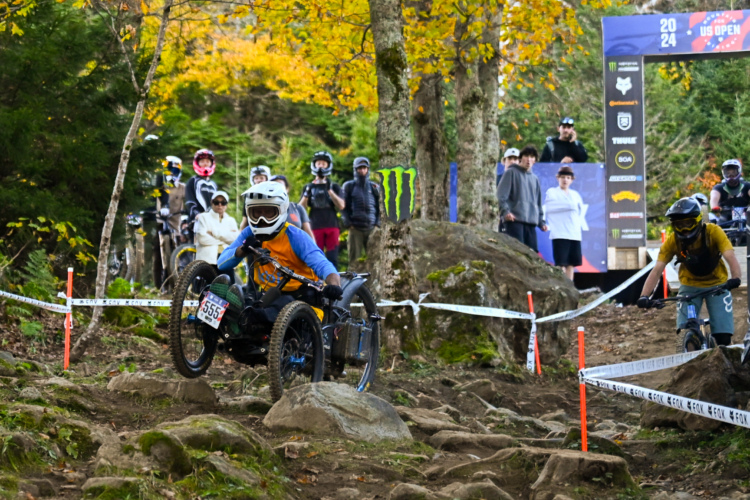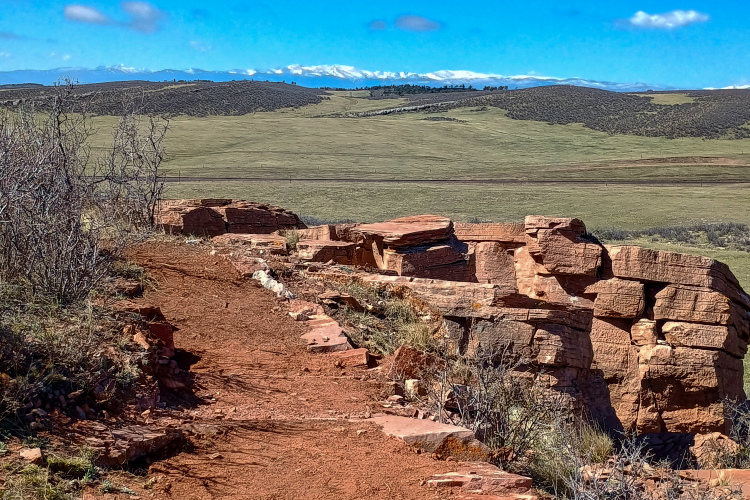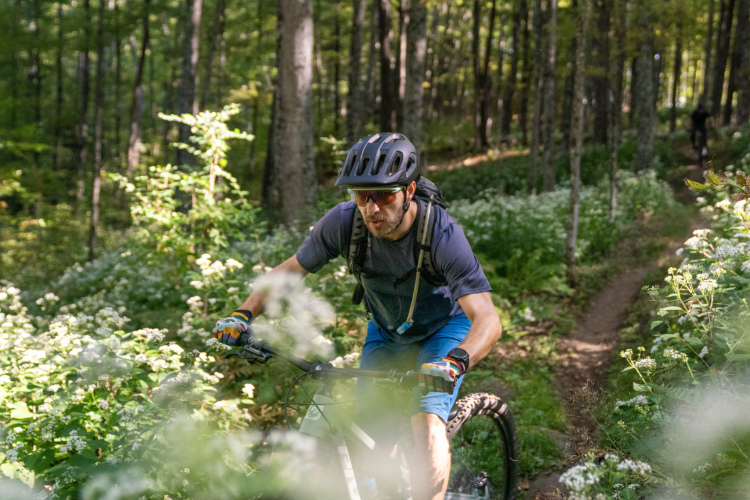
“I’ve never had a dream in a wheelchair. When I dream, I’m not in a chair,” adaptive athlete Jeremy P. McGhee reflected. “In the morning, I wake up from these awesome adventures — skiing, snowboarding, surfing, playing football, having sex — and it’s like this wall of reality in the morning and like, ‘Okay, here goes the struggle again.’ But that’s why I got a bike, because I wanted that feeling again. And I think when you have that feeling, and you’re on trail or in nature to some capacity, [there’s] something about that formula that really helps me deal with my shit.”
As McGhee and many other adaptive athletes show, everyone loves the sensation of being out in the woods, ripping down fast trails on a bicycle. Unfortunately, many mountain bike trails that could accommodate the wider wheelbase of an adaptive mountain bike have a few pinch points or awkward features that keep adaptive riders off the trails.
But in Northwest Arkansas, the Trailblazers are tackling this problem in their trail system head-on.

The Trailblazers are building trails with “universal design”
The Trailblazers have partnered with accomplished adaptive mountain bikers to analyze their existing trails and figure out how they can make small adjustments to make them compatible with adaptive mountain bikes. The collaboration was kickstarted when local adaptive rider Brian Carlson bumped into Gary Vernon, Director of Outdoor Recreation and Trail Innovation for the Runway Group, out on the trails in Bentonville.
The Trailblazers “lead the development of an innovative regional movement that places cycling, trails, and active transportation infrastructure at the heart of a vibrant, healthy, and sustainable culture,” according to their website. This work encompasses both hard-surface and soft-surface trails, but in Bentonville, the pavement and the singletrack mesh seamlessly into one symbiotic ride experience, which is especially important for adaptive mountain bikers.
“We noticed that we had a bunch of miles of trail that we could make small changes to, and it would open up miles for [adaptive riders],’ said Uriah Nazario, Director of Soft-Surface Trails for the Trailblazers. “And not only that, but they could ride out of their doors, from their homes, and into the trails without needing assistance.”
Building for adaptive mountain bikes doesn’t mean making trails easier. “We want to be able to ride all the trails that everybody else is,” said adaptive athlete Karl Whitcombe. “We still want to ride over jumps. We still want to go down rock gardens. We still want to go off drops. We just want to be out there.”
In some places, the builders only needed to make small tweaks to make the trails adaptive-bike-friendly. However, in others, the Trailblazers realized that they’d need to build an entire jump line from scratch to accommodate adaptive mountain bikes. So, they jumped into the process feet-first by launching McGhee off a moto ramp into an airbag to track the flight pattern of a heavy bike with a long wheelbase.

A documentary takes shape
As they began to film their work building trails with “universal design” — an ethos dictating that trails be built for all riders — the Trailblazers realized that the Beyond the Ashes story was about much more than just a new way of building trails. The true story is about all the athletes who have had life-changing injuries, and have persevered and risen from the ashes to continue pursuing the sport they love.
“We just kept getting more athletes and getting more of their stories. And it just turned into this film, this documentary that really had so much to tell, and so many stories,” said Nazario.
“I thought I would just be a little bit biased, but when I saw the final clip, I was absolutely, like… it just reinvigorated me to get out there and just see what all I could conquer and help with these guys.”
Having had the chance to view the film myself, I can attest that it drives home the importance of building trails for riders of all different types, including those with wide-wheelbase bikes. The passion that all the athletes interviewed have for the sport is infectious, and with trail advocates like the Trailblazers working to build more adaptive-friendly trails, the riding opportunities are expanding dramatically.

Sharing universal trail building guidelines far and wide
The Trailblazers have spent the last couple of years honing their universal trail-building methods, but despite the time and money invested, they aren’t keeping the tools and tactics to themselves. They’re sharing the playbook with anyone who asks.
“We actually got contacted by some friends in Canada, and we’ve gotten contacted from other sources around, [and] they’re just like, ‘Hey, we somehow got your contact from somebody, and we would like to know more,’” said Nazario. “Unfortunately, a lot of my drawings are probably incomprehensible… so I’ve tried my best to give them some diagrams to help them, as well as send them some information that our consultants have helped us with.
“This is exactly why we want to do that […] because we hope that it spreads, and we hope that other communities and other trail builders can take a step back and say, ‘Hey, if we do XYZ, this will change this trail — not in its level of fun or engagement — but it will change to where a whole other group of cyclists can ride it, have fun and utilize it,’” Nazario concluded.

Universal trail design can grow the mountain biking pie, but there are still barriers to entry
While the number of adaptive mountain bikers may be small in some places currently, Nazario believes that the lack of accessible trails is one of the top reasons why more people with disabilities don’t ride. As the many stories in the film showed, most riders didn’t realize that adaptive mountain biking even existed, let alone that they could participate in it.
“All my friends [were] riding [during the summer], and I came across a picture of this crazy bike. ‘What is this?’ said McGhee. “It’s the bike I ride now, full suspension with a drivetrain. It was the first one ever. Now there’s all kinds of bikes and manufacturers and options, but at that time, it was the first one. ‘I need to get this.’ It was $9,400, and I had $9,800 in my bank account, and I wrote the check. I just wanted to get back on the trail.”
Unfortunately, as McGhee illustrates, the second major barrier to entry is the cost of the bikes. McGhee purchased his bike years ago, and Nazario estimates that full-suspension electric adaptive bikes currently start around $15,000 and go up from there. Despite the high price tags, most riders need to get on a waiting list in order to get a bike.


To help overcome that barrier as well, the OZASA Off-Road, hosted by the Ozark Adaptive Sports Association, invites adaptive athletes from around the world to come and ride in Bentonville every fall. And for riders interested in trying it out for the first time, OZASA brings in a fleet of bikes from the biggest manufacturers that riders can try free of charge. They host clinics to teach riders how to use the specialized equipment, and safety riders are on hand to help the adaptive athletes who are new to the sport.
Bentonville has been so successful at breaking down barriers for adaptive athletes that they’re moving from across the country so they can live and ride in Bentonville. Some of the most influential riders in the community, like Carlson, moved for the trails. And after every OZASA Off-Road event, at least one attendee has relocated to Bentonville.
The work here is paying off — and it can pay off in your community, too.
Beyond the Ashes premieres June 19th
The feature-length documentary, titled Beyond the Ashes, is set to premiere on June 19th at the Bentonville Film Festival. The documentary was filmed and produced by Tim Johnson, Brock Wagner, and Jason Williams, with support from Uriah Nazario, Bianca Montoya, Brian Carlson, and John Hunter. They plan to take their meaningful work on the road to all the major outdoor film festivals.
If you don’t want to wait until June 19th for the premiere, you can get a sneak peek here:











1 Comments
Jun 11, 2025